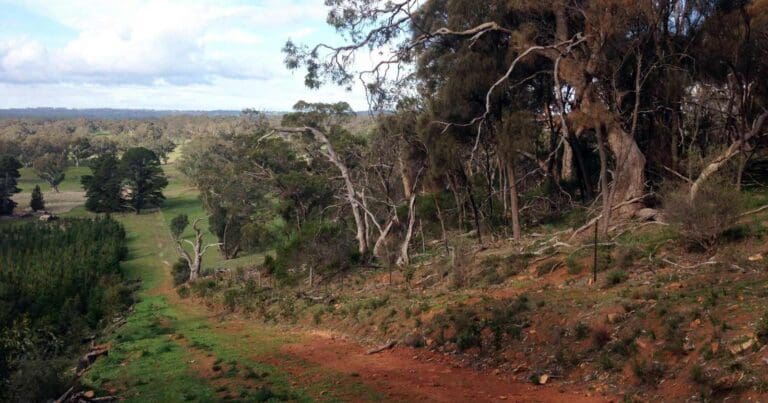Hike at a Glance
Max elevation: 520m
Min elevation: 497m
Total Ascent: 29m
Hike overview
Explore the regenerating landscapes of Kaiserstuhl Conservation Park with the Stringybark Circuit. This moderately challenging (grade 3) 2.7-kilometre loop trail winds through the park's eastern section, offering a rewarding exploration in roughly 1.5 hours.
The Stringybark Circuit provides a taste of the park's diverse flora. Traverse a combination of open grassy areas and pockets of denser stringybark forest, keeping an eye out for the park's abundant plant and animal life. This loop trail offers a chance to fully experience the park's eastern reaches without retracing your steps.
Gallery
Got some great shots from this hike? Upload your photos here to inspire others and show off the beauty of the trail!
Uploading your photos doesn’t mean you lose ownership. You can be credited for your contributions, and you can request removal at any time.
Walk map and GPX file
Max elevation: 520 m
Min elevation: 497 m
Total climbing: 29 m
Total descent: -29 m
Content use
Every trail on this site has been personally mapped and refined to support Australia’s hiking community. While some info comes from land managers, each listing reflects significant personal work. Please don’t upload GPX files or content from this site to AllTrails or any other platform. This is a free community initiative—your respect helps keep it that way.
Getting there
Closest towns to this walk: Angaston, Balhannah, Hahndorf, Kaiserstuhl, Lobethal, Lyndoch, Mount Barker, Nuriootpa, Tanunda, Woodside
Getting to the trailhead in Kaiserstuhl Conservation Park.Kaiserstuhl Conservation Park is conveniently located just 12 kilometres southeast of Tanunda in the Barossa Valley. For those travelling by car, follow Tanunda Creek Road until you reach the park entrance. Remember, there’s no designated car park, so find a safe spot to leave your vehicle along the roadside outside the park boundary.
About the region
Nestled amidst the Barossa Valley's rolling hills, Kaiserstuhl Conservation Park offers a scenic escape for nature lovers. This park boasts two walking trails, catering to a range of fitness levels. Explore a diverse landscape that encompasses creeks, rocky outcrops, pockets of low forest, scrubland, and open grasslands. As you traverse the trails, be rewarded with panoramic views that stretch across the ranges towards the Barossa Valley.
The Wallowa Hike is a more comprehensive route, showcasing the park's key features. This trail leads you to a scenic lookout with breathtaking views, and past intriguing rock formations like Horse Head Rock, named for its resemblance to an equine head. Capped Rock provides another captivating sight - a horizontal slab precariously balanced on a vertical outcrop, offering a challenge for photographers.
For a shorter exploration, choose the Stringybark Loop. This trail offers a glimpse into the park's rich biodiversity, with opportunities to spot native animals like kangaroos grazing in the open grasslands at dawn or dusk. Keep your eyes peeled for echidnas and possums foraging for food in the twilight hours.
While the park itself lacks amenities, nearby towns and other parks in the region offer toilet and picnic facilities for your convenience. There are no designated car parks, but parking along the road bordering the park is permitted.
Established primarily to protect the northernmost population of brown stringybark trees, Kaiserstuhl Conservation Park shelters around 400 plant species. These stringybark trees have a distinctive multi-stemmed, mallee-like appearance, a result of past practices where they were regularly trimmed to provide fuel for brick kilns.
The park is also a haven for native birds, including blue wrens, parrots, honeyeaters, finches, and thornbills. Sadly, habitat fragmentation due to human activity is causing population decline for many bird species in the Mount Lofty Ranges, even within protected areas. These parks can become too small to sustain viable populations of certain species, leading to localized extinction as older birds die.
Similar trails nearby
Looking for hikes and trails in Kaiserstuhl Conservation Park or nearby? Try these walks with a similar grade.
Track grade
Grade 3 (Moderate) - Walks for Most Fitness Levels: Grade 3 on the AWTGS represents moderate walking tracks. These are ideal for walkers with some fitness who are comfortable with some hills and uneven terrain. While suitable for most ages, some bushwalking experience is recommended to ensure a safe and enjoyable experience. Tracks may have short, steep hill sections, a rough surface, and many steps. The total distance of a Grade 3 walk can be up to 20 kilometers.
Explore safe
Plan ahead and hike safely! Carry enough water, pack layers for changing conditions, and bring safety gear like a torch, PLB, and reliable communication device. Check official sources for trail updates, closures, and access requirements, and review local weather and bushfire advice. Most importantly, share your plans with someone before you go. Being prepared makes for a safer and more enjoyable hike! Stay Safe, Explore More, and Always #ExploreSafe.
Packing checklists
What you carry in your pack depends on factors like weather, terrain, and your adventure type. Not sure what to bring? My free planning, food, and packing checklists are a great starting point, covering day hikes, overnight trips, and multi-day adventures. Use them to customise your kit and always prioritise safety.
Let someone know
Before heading out, take a moment to fill out your trip intentions form. It’s a quick way to share your hike details with family or friends. If something goes wrong, they can notify emergency services, ensuring a faster response and peace of mind. Stay safe and enjoy your adventure
Suggest an edit
Spotted a change on this trail? Maybe there are new features, the route has shifted, or the trail is permanently closed. Whatever the update, I’d love your input. Your feedback helps fellow hikers stay informed and ensures that our trail info stays fresh and reliable.
Acknowledgement of Country
Trail Hiking Australia acknowledges the Traditional Owners of the lands on which we hike and pay respects to their Elders, past and present, and we acknowledge the First Nations people of other communities who may be here today.






